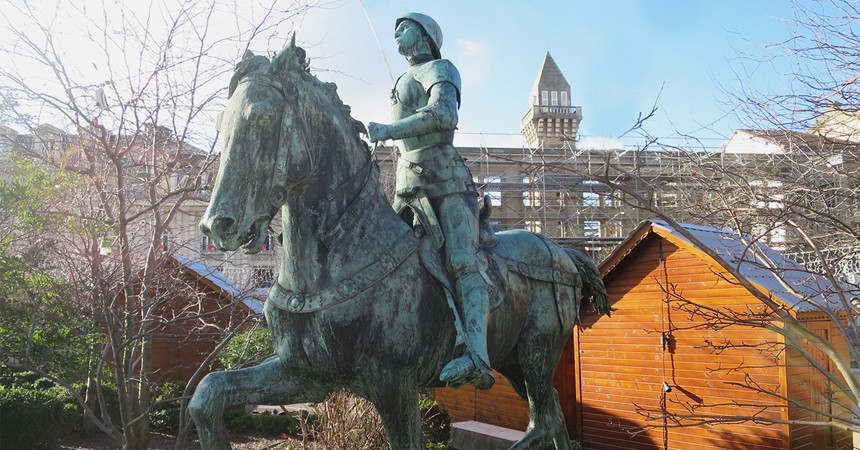An ordinary girl with an extraordinary vision
Born around 1412, Joan d’Arc was the daughter of a poor farmer in the village of Domrémy, in northeastern France. Joan was never taught to read or write; however, her mother instilled in her a deep love for the Catholic Church and its teachings.
At the time Joan was growing up, France was being torn apart by a bitter conflict with England in which England had gained the upper hand, later known as the Hundred Years’ War.
In 1420 King Henry V was made the ruler of both England and France, and England occupied much of northern France, including Joan’s village. Many families were forced to abandon their homes under threat of invasion.
In 1425, at 13 years of age, Joan began to hear voices and receive visions. Joan determined they had been sent by God to give her a mission of overwhelming importance: to save France by expelling its opponents, and to install Charles as its rightful king.
As part of this divine mission, Joan took a vow of chastity. At the age of 16, after her father attempted to arrange a marriage for her, she successfully convinced a local court that she should not be forced to accept the match.
Joan’s journey to Orléans
In May 1428, at age 16, Joan made her way Vaucouleurs, a nearby stronghold of those loyal to Charles. Initially rejected by the local magistrate, she persisted. She eventually gained a small band of followers who believed her claims to be a virgin who was destined to save France. When the magistrate relented, Joan cropped her hair and dressed in men’s clothes to make the 11-day journey across enemy territory to the site of Prince Charles VII’s palace.
Joan promised Charles she would see him crowned king at Reims, the traditional site of French royal investiture, and asked him to give her an army to lead to Orléans, then under siege from the English. Against the advice of most of his counsellors and generals, Charles granted her request and furnished Joan with a small army.
On April 27, 1429, she set out for Orleans, besieged by the English since October 1428. On April 29, as a French sortie distracted the English troops on the west side of Orleans, Joan entered unopposed by its eastern gate. She brought greatly needed supplies and reinforcements and inspired the French to a passionate resistance. She personally led the charge in several battles and on May 7 was struck by an arrow. After quickly dressing her wound, she returned to the fight, and the French won the day.
On May 8, the English retreated from Orleans.
Joan’s capture
After such a miraculous victory, Joan’s reputation spread far and wide and she had put courage back into the hearts of the embattled French. After King Charles VII’s coronation in July 1429, Joan and her family were ennobled as a reward for her actions.
A truce with England followed that left Joan with little to do. She argued that the French should press their advantage with an attempt to retake Paris, but Charles wavered, and was warned that Joan was becoming too powerful.
In May 1430, while leading another military expedition against the English occupiers of France, Bourguignon soldiers captured Joan and sold her to the English.
A Witch hunt
Her capture was a morale boost for the English, who set out to vilify the woman who had done so much damage to their military campaigns. After her trial and subsequent guilty verdict, Joan was executed in Rouen on May 30, 1431, by being burned alive.
Once her ashes had been scattered in the Seine River, Joan’s detractors hoped her name would be erased from history, but her name has burned more brightly in the hearts and minds of the French ever since then.
The humble farm girl turned the tide for the French in the closing years of the Hundred Years’ War. Her claims that the divine voices she heard would lead France to victory made her one of the most celebrated figures of late medieval history.
From witch to saint
Twenty years after her execution, King Charles VII ordered a new trial and cleared her name.
Over the following centuries, Joan of Arc’s story gained notoriety and she attained mythic stature and was considered a heroine in France, inspiring numerous works of art and literature.
Four hundred years after Joan’s heroic journey, in 1869, the Bishop of Orleans made an emotional speech about the importance of Joan as a patriot and a Catholic. With eleven other bishops present, Bishop Dupanloup of Orleans made a solemn appeal to Pope Pius IV in Rome to begin the process of canonisation.
In 1909, Pope Pius X declared, "Joan of Arc has shone like a new star destined to be the glory not only of France but of the Universal Church as well,” and she was officially declared Blessed on April 18, 1909.
Joan of Arc was canonised by Pope Benedict XV in 1920 at St Peter’s Basilica. The same year, Joan of Arc became a patron saint of France. Her celebrated feast day in May 30, the day of her death.
International Women's Day 2018
In honour of International Women's Day (8 March), MNnews is celebrating the achievements and incredible contributions of Catholic women on behalf of the Church and the Catholic Faith.
Click here to more stories of astounding women.
